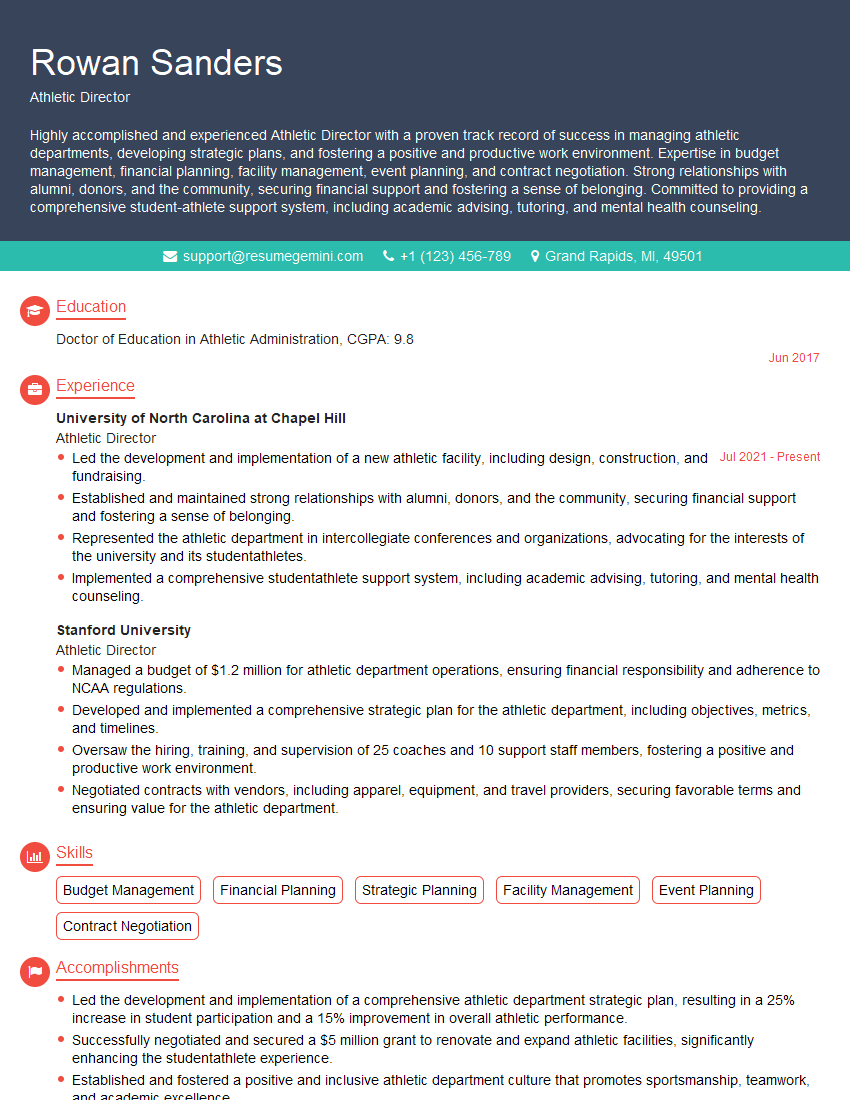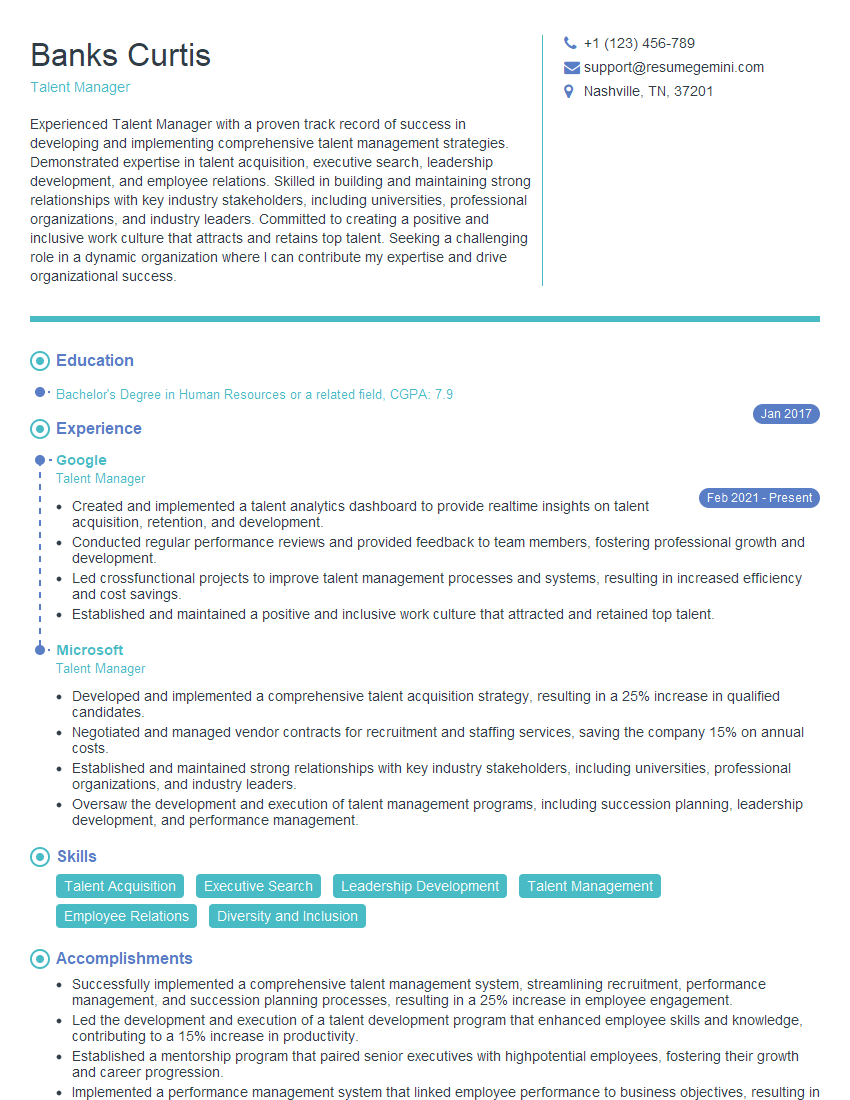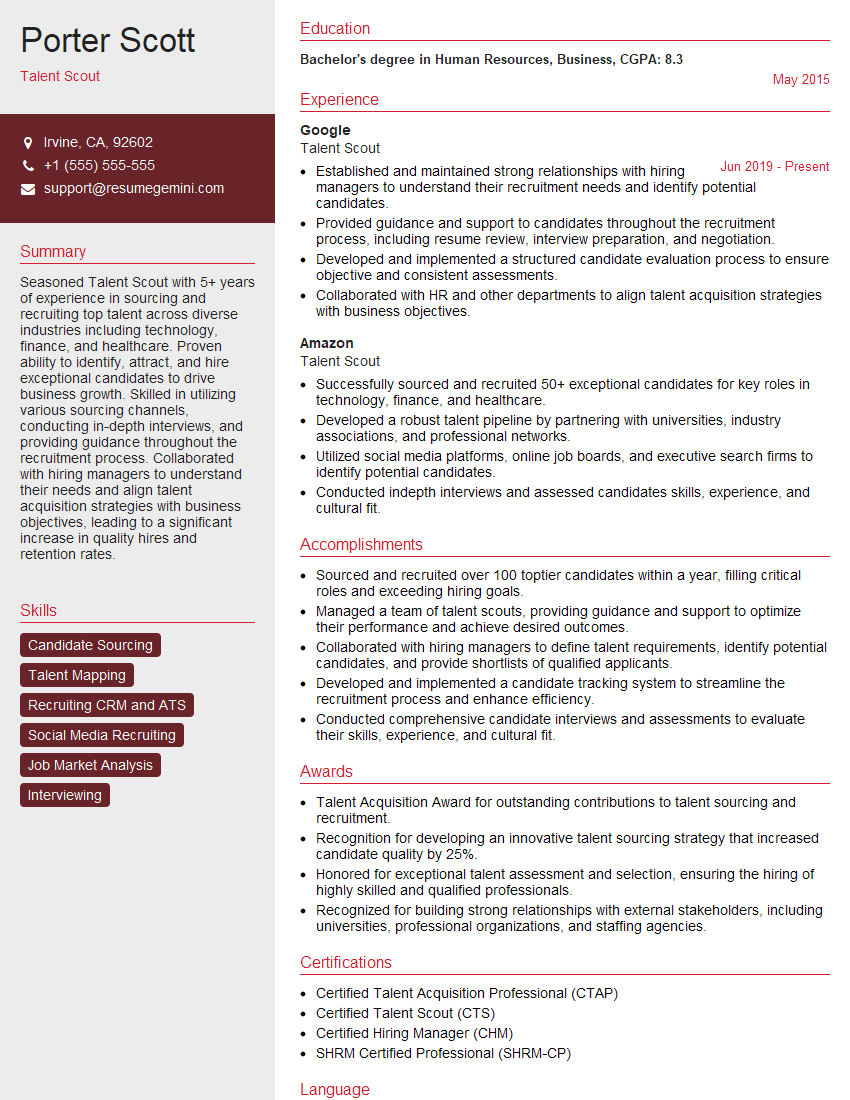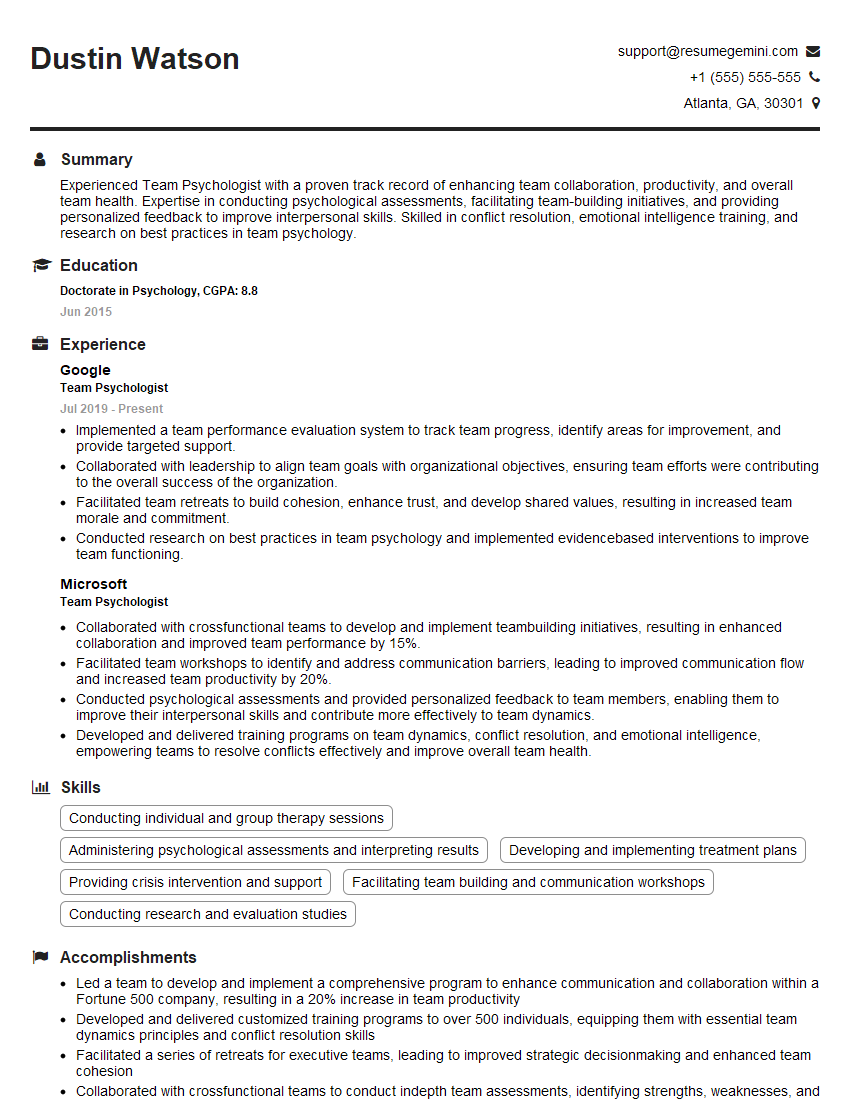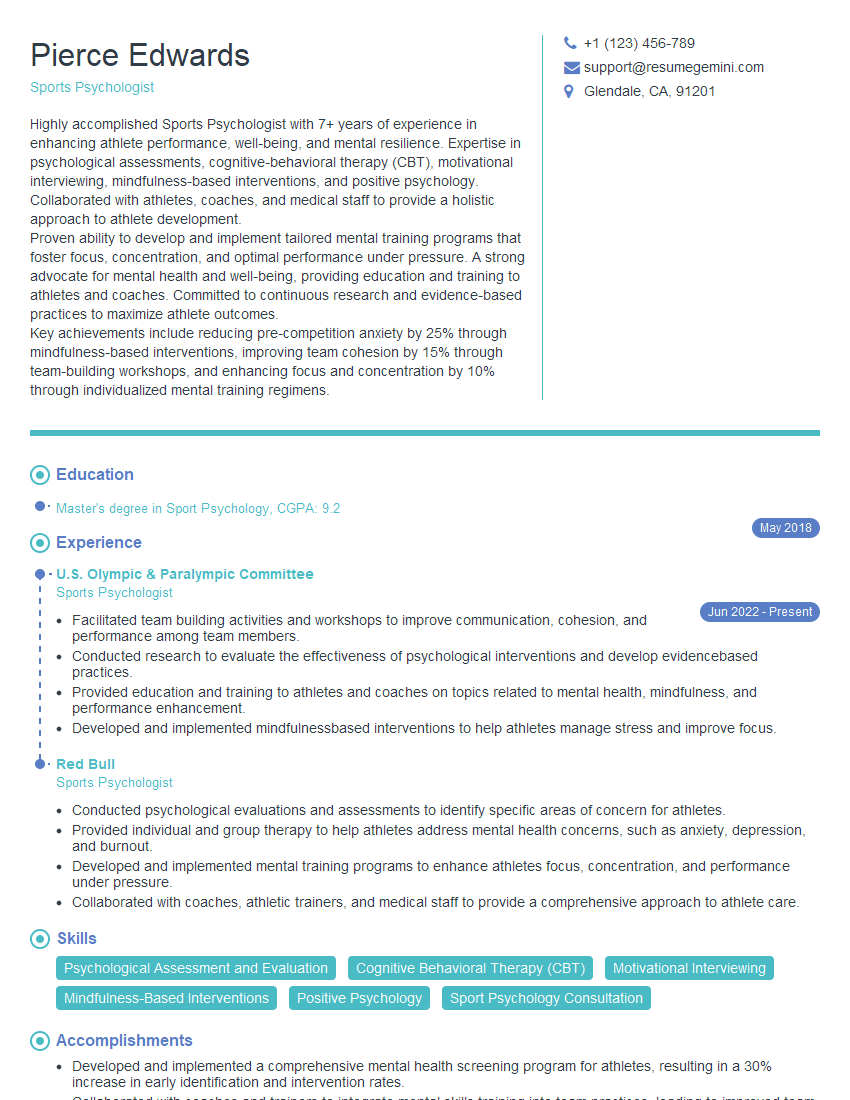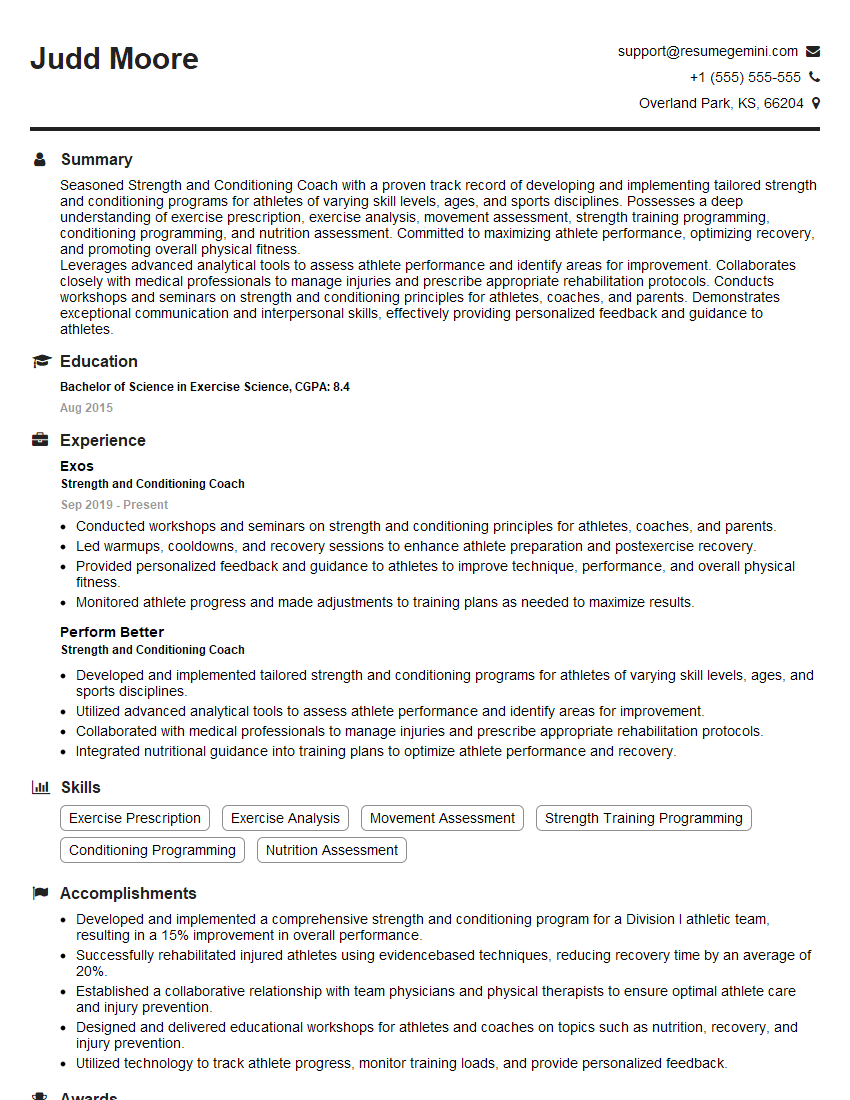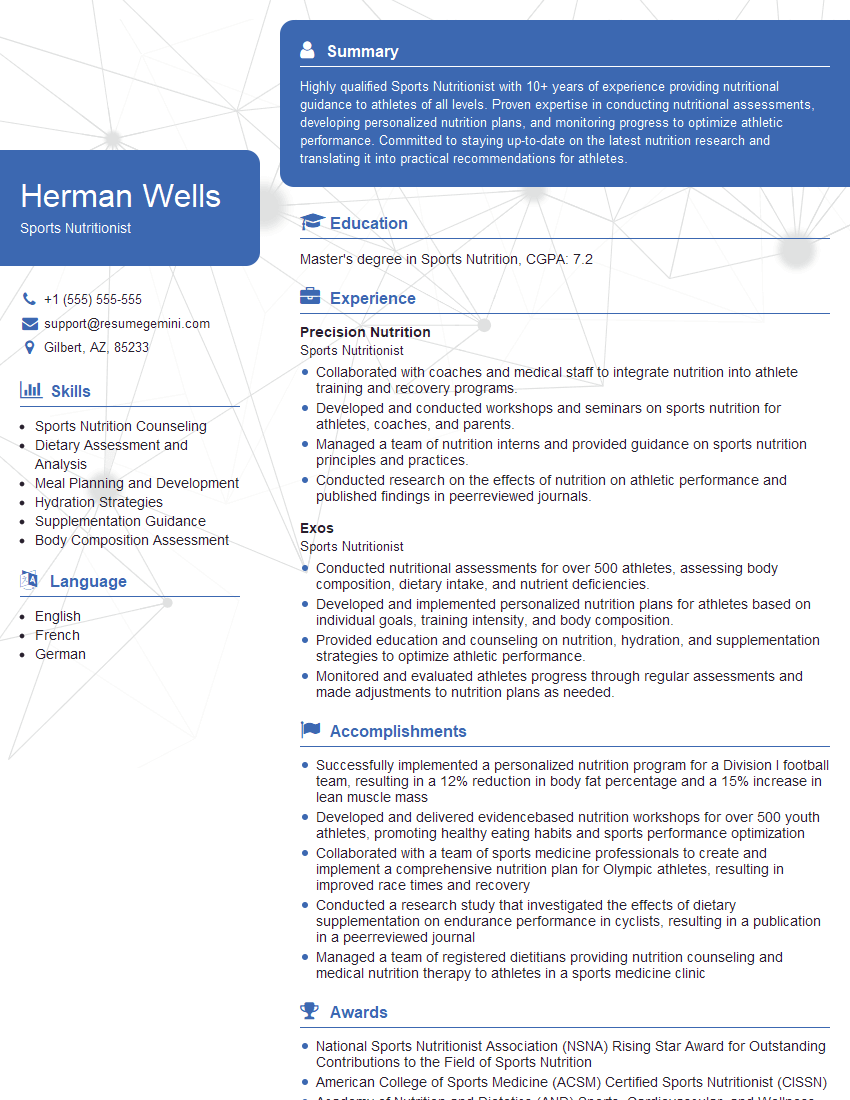The right preparation can turn an interview into an opportunity to showcase your expertise. This guide to Player Management and Motivation interview questions is your ultimate resource, providing key insights and tips to help you ace your responses and stand out as a top candidate.
Questions Asked in Player Management and Motivation Interview
Q 1. Describe your experience in developing individual player performance plans.
Developing individual player performance plans is a crucial aspect of player management. It’s about creating a tailored roadmap for each athlete to reach their full potential. This involves a thorough assessment of their current skills, identifying areas for improvement, setting realistic goals, and outlining specific strategies to achieve those goals. The process is iterative and requires regular monitoring and adjustments.
My approach begins with a detailed performance analysis. This includes reviewing game statistics, observing training sessions, and conducting one-on-one interviews to understand the player’s strengths, weaknesses, aspirations, and any challenges they’re facing. Based on this assessment, I collaborate with the player to set SMART goals – Specific, Measurable, Achievable, Relevant, and Time-bound. For example, a goal might be: ‘Improve passing accuracy from 70% to 80% within the next two months by focusing on technique drills three times a week’. We then outline a training plan that incorporates specific exercises, drills, and strategies to help them achieve these goals. The plan also includes regular feedback sessions to track progress, make necessary adjustments, and keep the player motivated.
For example, I once worked with a young basketball player who struggled with free throws. After analyzing his technique, we identified a flaw in his shooting motion. We developed a plan that included dedicated free-throw practice sessions, video analysis of his shots, and drills focused on correcting his form. This resulted in a significant improvement in his free-throw percentage over the season.
Q 2. How do you identify and address burnout in athletes?
Athlete burnout is a serious concern that can significantly impact performance and well-being. It’s characterized by physical, emotional, and mental exhaustion, often stemming from excessive training, pressure, or lack of recovery. Identifying and addressing burnout requires a multifaceted approach.
My strategy involves proactive monitoring. This includes regular communication with players, observing their behavior during training and games (looking for signs of fatigue, decreased motivation, or irritability), and utilizing performance metrics to detect any decline in their physical or mental capabilities. I also utilize questionnaires and surveys to assess levels of stress, motivation, and satisfaction. If burnout is suspected, I follow a structured approach. This involves open communication with the athlete to understand the root causes of their burnout, tailoring a recovery plan that incorporates reduced training volume, increased rest and recovery time, and potentially seeking professional help from sports psychologists or therapists. It’s crucial to address not only the physical aspects but also the emotional and psychological factors that contribute to burnout. This might involve techniques like mindfulness, stress management strategies, or helping the athlete find a healthy work-life balance.
For instance, I once worked with a swimmer who was experiencing significant burnout due to intense training schedule and competitive pressures. We implemented a reduced training plan, incorporated active recovery methods such as yoga and light stretching, and arranged for him to speak with a sports psychologist. This holistic approach helped him recover and return to competition with renewed energy and enthusiasm.
Q 3. Explain your approach to motivating players with differing skill levels and personalities.
Motivating players with diverse skill levels and personalities requires a highly personalized approach. There’s no one-size-fits-all solution. My approach is based on understanding individual needs and tailoring motivational strategies accordingly.
For players with high skill levels, the focus shifts towards maintaining motivation and striving for excellence. This often involves setting challenging yet achievable goals, providing opportunities for leadership roles, and fostering a culture of continuous improvement. For players with lower skill levels, the emphasis is on building confidence and celebrating small victories. Positive reinforcement, constructive feedback, and providing opportunities for skill development are crucial here. I use different motivational techniques depending on individual personalities. Some players respond well to public praise and recognition, while others prefer more private encouragement. Some are highly competitive and thrive under pressure, while others need a supportive and less demanding environment. Regular communication, active listening, and adapting my strategies based on their individual responses are key to success.
For example, I worked with a team that included both experienced veterans and young rookies. The veterans thrived on challenging goals and team leadership roles, while the rookies needed consistent positive feedback and individualized attention. By providing both groups with the support and motivational strategies they needed, the team as a whole saw significant improvements in performance and overall morale.
Q 4. What strategies do you employ to build team cohesion and improve morale?
Building team cohesion and improving morale are essential for optimal team performance. My strategies focus on creating a positive team environment, fostering strong interpersonal relationships, and promoting a sense of shared purpose.
I implement team-building activities both on and off the field. This could include social events, group outings, or collaborative projects. I encourage open communication, active listening, and conflict resolution within the team. Regular team meetings provide a forum for players to voice their concerns, share ideas, and collaboratively address challenges. Establishing clear team roles, responsibilities, and expectations creates a sense of unity and purpose. I also prioritize celebrating successes, both individual and collective. This helps reinforce positive behaviors and strengthen the team’s sense of accomplishment. It’s essential to create a culture of mutual respect, support, and trust among teammates. This ensures that players feel valued, respected, and empowered within the team.
One example involved a soccer team that initially lacked cohesion. By introducing team-building exercises, fostering open communication, and celebrating team successes, we built a strong team spirit. This resulted in increased player performance and a more positive and collaborative team environment.
Q 5. How would you handle a conflict between two key players on your team?
Conflicts between key players can disrupt team dynamics and negatively impact performance. My approach to handling such conflicts involves a structured and impartial process.
First, I would meet individually with each player to understand their perspectives, concerns, and the root causes of the conflict. It’s crucial to create a safe and supportive environment for them to express themselves openly and honestly. Then, I would facilitate a joint meeting involving both players, where each player can share their perspective and listen to the other’s point of view. The goal is not to assign blame but to understand the situation from multiple angles. I would work with the players to identify common ground and collaboratively develop a solution that is acceptable to both. This often involves setting clear expectations, agreeing on communication protocols, and establishing a plan to address any underlying issues. Regular follow-up meetings are important to ensure that the solution is working effectively and to address any lingering issues. In some cases, it may be beneficial to involve a mediator or sports psychologist to assist with the conflict resolution process.
In one instance, a disagreement between two star players concerning playing time escalated into a major conflict. By utilizing individual meetings followed by a facilitated joint meeting, we identified the root cause of the conflict, agreed on a fair rotation strategy, and developed a communication plan. This prevented further disruption and restored a positive dynamic between the players.
Q 6. Describe a time you had to manage a player’s disciplinary issue.
Managing disciplinary issues requires a fair, consistent, and supportive approach. My approach centers around understanding the context of the infraction, addressing the issue directly, and implementing appropriate consequences.
I begin by gathering all the relevant facts of the situation. This may involve speaking to witnesses, reviewing video footage, or obtaining written reports. Next, I meet with the player to discuss the incident, listen to their explanation, and provide them with an opportunity to express their remorse or perspective. I then clearly outline the violation of team rules or expectations. The consequences depend on the severity of the infraction and the player’s history. This can range from a verbal warning, temporary suspension from training or games, to more serious consequences depending on the team’s policies and the nature of the violation. Throughout the process, I emphasize education and rehabilitation. The focus isn’t solely on punishment, but also on helping the player learn from their mistakes and avoid similar situations in the future. Clear communication, consistent application of rules, and support for the player’s personal growth are key components in managing disciplinary issues effectively.
In one situation, a player violated team curfew. After a thorough discussion, we agreed on a consequence (community service), and I offered support in helping him manage his time better. This approach ensured the player understood the seriousness of his actions, took responsibility, and learned from his mistake.
Q 7. How do you measure the effectiveness of your player development programs?
Measuring the effectiveness of player development programs requires a multi-faceted approach that goes beyond simply looking at win-loss records. A comprehensive evaluation involves several key metrics.
Firstly, I track player performance metrics. These can be quantitative (e.g., improved speed, increased shooting accuracy, higher points per game) or qualitative (e.g., better decision-making, improved teamwork, increased confidence). I use objective data collected throughout the season, including game statistics, training performance data, and coach evaluations. Secondly, I conduct regular player assessments, including one-on-one interviews and questionnaires to gauge player satisfaction, self-perception of improvement, and feedback on the training program. This qualitative data provides valuable insights into the program’s impact on player morale and well-being. Thirdly, I compare pre- and post-program assessments. By comparing player performance metrics, skill levels, and psychological assessments before and after the program, I can quantify the extent of the improvement. Finally, I seek feedback from coaches and other stakeholders involved in the player’s development. Their perspectives provide a broader understanding of the program’s success.
Combining these methods offers a more complete picture of the program’s effectiveness. For example, tracking improvements in passing accuracy alongside player feedback on confidence and enjoyment paints a more holistic portrait of player development than relying on win-loss records alone.
Q 8. What are your preferred methods for providing constructive feedback to players?
Constructive feedback is crucial for player development. My approach prioritizes a balanced mix of positive reinforcement and specific, actionable suggestions for improvement. I avoid generic praise and instead focus on observable behaviors and their impact on performance.
- The SBI Model: I frequently use the Situation-Behavior-Impact model. This involves describing the specific situation (Situation), outlining the player’s behavior (Behavior), and explaining the impact of that behavior on the team or the game (Impact). For example, ‘In the last game (Situation), you hesitated to shoot when open (Behavior), resulting in a missed scoring opportunity and a slower offensive rhythm (Impact).’ This approach is clear, objective, and focuses on actions, not personality.
- Focus on Specific Skills: Feedback is tailored to the individual player’s skill set and developmental needs. Instead of saying ‘You need to improve your shooting,’ I’d say, ‘Your follow-through needs improvement; let’s work on maintaining a consistent elbow position during your shot.’ This makes the feedback actionable.
- Two-Way Conversation: I encourage open dialogue. After providing feedback, I actively listen to the player’s perspective and discuss strategies for improvement collaboratively. This builds trust and commitment to the development plan.
- Positive Framing: Even when addressing weaknesses, I emphasize the player’s strengths and potential for growth. For example, ‘Your passing is excellent, but improving your shot selection will make you an even more valuable player.’ This approach helps maintain morale and motivation.
Q 9. How do you foster a positive and supportive team environment?
A positive and supportive team environment is the bedrock of success. I cultivate this through several key strategies:
- Building Camaraderie: I organize team-building activities, both on and off the field, to foster strong interpersonal relationships among players. This could involve social gatherings, volunteer work, or even friendly competitions.
- Open Communication: I establish a culture of open communication where players feel comfortable sharing their concerns, ideas, and feedback without fear of judgment. This requires actively listening, creating a safe space for discussion and ensuring everyone feels valued.
- Respectful Interactions: I model respectful behaviour and enforce a zero-tolerance policy for bullying or negativity. This establishes a foundation of mutual respect and trust.
- Celebrating Successes: I actively celebrate both individual and team achievements, reinforcing positive behaviour and fostering a sense of shared accomplishment. This could be through team meetings, awards, or simple verbal acknowledgment.
- Focus on Learning: Mistakes are viewed as learning opportunities. I emphasize the importance of effort and perseverance, creating an environment where players aren’t afraid to take risks.
Q 10. How do you adapt your motivational strategies based on different player needs?
Motivation is a nuanced process that varies significantly between individuals. I tailor my approach by identifying each player’s unique motivational drivers and adapting my strategies accordingly.
- Intrinsic vs. Extrinsic Motivation: Some players are intrinsically motivated (driven by internal factors like passion and enjoyment), while others are extrinsically motivated (driven by external rewards like recognition or trophies). I understand the importance of aligning my approach with the dominant motivational style.
- Goal Setting: Individual goal setting is paramount. I work with each player to define achievable, specific, and measurable goals aligned with their skill level and aspirations. This could range from technical skills goals (‘Improve free throw accuracy by 10%’) to strategic goals (‘Increase assists per game by 2’).
- Positive Reinforcement: I frequently use positive reinforcement by rewarding effort, improvement, and positive contributions. This is not just about rewards, but genuine acknowledgement and recognition.
- Addressing Challenges: I understand the importance of addressing any challenges or obstacles that prevent players from reaching their goals. This may involve providing additional coaching, seeking advice from other professionals (such as sports psychologists or nutritionists), or adjusting the training program to address specific weaknesses.
- Differentiated Instruction: Recognizing that players learn differently, I utilize a variety of teaching and training methods to cater to different learning styles. This might include visual aids, demonstrations, simulations, or individualised feedback.
Q 11. Explain your understanding of sports psychology principles and their application.
Sports psychology principles are integral to effective player management. I understand and apply several key concepts:
- Goal Setting Theory: Setting specific, measurable, achievable, relevant, and time-bound (SMART) goals is crucial. I work with players to establish short-term and long-term goals that provide a sense of purpose and direction.
- Self-Efficacy: Building players’ belief in their ability to succeed is essential. I use positive reinforcement, successful experiences, and vicarious learning to boost self-efficacy.
- Motivation Theories: I apply various motivation theories (e.g., self-determination theory, expectancy theory) to understand players’ needs and tailor strategies accordingly. This includes understanding intrinsic and extrinsic motivations.
- Stress and Anxiety Management: I help players develop coping mechanisms to manage stress and anxiety related to competition. This might involve relaxation techniques, imagery, or cognitive restructuring.
- Team Cohesion: I focus on building strong team dynamics and promoting positive interpersonal relationships to improve team performance and player well-being.
For instance, before a crucial game, I might use imagery exercises to help players visualize success and reduce pre-game anxiety. I also utilize motivational talks that focus on team unity and collective strength.
Q 12. How do you integrate performance data to inform player development strategies?
Performance data is invaluable for guiding player development. I integrate this data using a structured process:
- Data Collection: I gather data from various sources, including game statistics, training metrics (e.g., speed, strength, agility), and video analysis. I use tools to track progress and identify areas for improvement.
- Data Analysis: I analyze the data to identify trends, strengths, and weaknesses. This involves looking for patterns in performance and determining the factors that contribute to success or failure.
- Feedback and Goal Setting: I use the data to provide specific and targeted feedback to players and to help them set realistic and measurable goals. For example, if data shows a player’s shooting percentage is low, we can analyze video to identify technical flaws and develop a specific training plan to improve accuracy.
- Training Program Adjustment: I adjust training programs based on the analysis of performance data to address specific areas for improvement. This data-driven approach ensures that training is optimized for individual player development.
- Monitoring Progress: I continually monitor progress using performance data and adjust strategies as needed. This iterative process allows for ongoing optimization of the development plan.
Q 13. How do you identify and nurture the talent of young athletes?
Nurturing young athletes requires a holistic approach that goes beyond technical skill development. I prioritize:
- Early Identification: I actively scout and identify talented young athletes through various means, including participation in youth leagues, camps, and school programs.
- Skill Development: I focus on developing both fundamental and specialized skills appropriate for their age and developmental stage. This involves providing tailored instruction, using age-appropriate training methods, and ensuring a safe and fun learning environment.
- Physical Conditioning: I emphasize the importance of proper physical conditioning to prevent injuries and maximize performance potential. This includes age-appropriate strength training, flexibility exercises, and cardiovascular conditioning.
- Mental Toughness: I build their mental resilience by teaching strategies to manage pressure, setbacks, and competition-related stress. This might involve mindfulness techniques or goal setting strategies.
- Character Development: I emphasize the importance of sportsmanship, teamwork, discipline, and respect. These non-athletic attributes are crucial for long-term success, both in sports and in life.
- Supportive Environment: Creating a positive and supportive environment is crucial. This involves fostering teamwork, celebrating successes, and providing constructive feedback in a supportive way. Emphasis is on learning and improvement.
Q 14. Describe your approach to setting realistic goals and expectations for players.
Setting realistic goals and expectations is vital for player motivation and development. My approach involves:
- Individual Assessment: I conduct a thorough assessment of each player’s current skill level, strengths, weaknesses, and potential. This includes considering their physical capabilities, technical skills, tactical understanding, and psychological attributes.
- Collaborative Goal Setting: I work collaboratively with each player to set both short-term and long-term goals. These goals should be specific, measurable, achievable, relevant, and time-bound (SMART). The process ensures the players are invested in the goals.
- Progressive Challenges: I structure goals progressively, starting with achievable short-term goals that gradually increase in difficulty. This ensures players experience a sense of accomplishment and builds confidence.
- Regular Evaluation: I regularly evaluate progress toward goals, providing feedback and making adjustments as needed. This may involve adjusting timelines, modifying strategies, or providing additional support.
- Celebrating Milestones: I celebrate both small and large achievements, reinforcing progress and maintaining motivation. This creates a positive and encouraging environment.
- Addressing Setbacks: I help players cope with setbacks and disappointments, teaching them resilience and perseverance. This involves reframing setbacks as learning opportunities and fostering a growth mindset.
Q 15. How do you deal with underperforming players?
Addressing underperformance requires a multifaceted approach that goes beyond simply pointing out shortcomings. It starts with understanding the root cause. Is it a skill deficit? A lack of confidence? Burnout? Or perhaps external factors affecting their performance?
- Initial Assessment: I begin with a one-on-one meeting to discuss their performance objectively, focusing on specific instances and avoiding generalizations. I ask open-ended questions to understand their perspective and any challenges they might be facing.
- Skill Development: If the issue is skill-based, I collaborate with coaching staff to create a personalized training plan. This involves identifying specific areas needing improvement and providing targeted drills and feedback.
- Confidence Building: For players lacking confidence, I focus on positive reinforcement and highlighting their strengths. Building trust and fostering a supportive environment is key. Setting achievable goals and celebrating small victories can help restore confidence.
- Addressing External Factors: Sometimes, underperformance stems from issues outside the playing field – personal problems, academic stress, etc. In such cases, I offer support and resources, connecting them with counselors or other professionals if needed. It’s crucial to treat the player holistically.
- Performance Monitoring and Adjustments: I consistently monitor their progress, adjusting the training plan or support as needed. Regular check-ins are essential to ensure the strategies are effective and to provide ongoing encouragement.
For example, I once worked with a young player whose performance dipped significantly. After several conversations, it emerged he was struggling with academic pressure. By connecting him with a tutor and adjusting his training schedule, we were able to address both his academic and athletic challenges, leading to a marked improvement in his performance.
Career Expert Tips:
- Ace those interviews! Prepare effectively by reviewing the Top 50 Most Common Interview Questions on ResumeGemini.
- Navigate your job search with confidence! Explore a wide range of Career Tips on ResumeGemini. Learn about common challenges and recommendations to overcome them.
- Craft the perfect resume! Master the Art of Resume Writing with ResumeGemini’s guide. Showcase your unique qualifications and achievements effectively.
- Don’t miss out on holiday savings! Build your dream resume with ResumeGemini’s ATS optimized templates.
Q 16. How do you handle pressure situations and maintain a positive attitude in a high-stakes environment?
High-stakes environments demand composure and a positive mindset. My approach focuses on preparation, proactive communication, and maintaining a growth mindset.
- Preparation is Key: Thorough preparation reduces anxiety. This includes meticulous game planning, anticipating different scenarios, and ensuring the team is physically and mentally prepared.
- Proactive Communication: Open and honest communication with the players before, during, and after high-pressure situations is vital. This ensures everyone is on the same page, understanding expectations and roles.
- Maintaining a Growth Mindset: Framing challenges as learning opportunities rather than setbacks is crucial. I emphasize the importance of effort and learning from mistakes, even during losses. Celebrating small victories and focusing on progress helps maintain a positive atmosphere.
- Modeling Positive Behavior: As a leader, I demonstrate composure and resilience under pressure. My actions influence the team’s response to challenging situations.
During a crucial playoff game, for instance, we faced a late-game deficit. Instead of panicking, I calmly addressed the team, highlighting our strengths and reminding them of our previous successes. Focusing on our process and executing our game plan, we managed to turn the game around, demonstrating the power of a positive attitude under pressure.
Q 17. Explain your experience in recruiting and selecting players for your team.
Player recruitment and selection is a rigorous process requiring a combination of objective evaluation and subjective judgment. It’s about finding players who not only possess the necessary skills but also fit the team’s culture and values.
- Identifying Needs: I begin by identifying the team’s specific needs and gaps. What skills are lacking? What kind of player would complement the existing roster?
- Sourcing Candidates: I leverage various resources, including scouting events, player databases, recommendations from coaches and other contacts, and online platforms.
- Skill Assessment: Objective evaluations involve assessing skills through tryouts, analyzing game footage, and using performance metrics.
- Character Evaluation: This is crucial. I look for qualities like teamwork, discipline, resilience, and a strong work ethic through interviews, observations, and feedback from references.
- Cultural Fit: It’s crucial that a player’s personality and values align with the team’s culture. A player with exceptional skills but a poor attitude can disrupt team dynamics.
For example, in recruiting a point guard, I prioritized not just exceptional ball-handling skills but also their leadership qualities and ability to work effectively with teammates. I conducted multiple interviews and observations to assess these intangible attributes before making a final decision.
Q 18. How do you ensure players are adhering to team rules and regulations?
Ensuring adherence to team rules and regulations requires a clear framework, consistent communication, and fair enforcement. It’s about fostering a culture of respect and accountability.
- Clearly Defined Rules and Regulations: The team’s rules and expectations must be clearly documented and communicated to all players and their parents (if applicable) at the start of the season.
- Consistent Enforcement: Rules must be applied consistently and fairly to all players, regardless of their status or performance level. Inconsistency undermines trust and respect.
- Educational Approach: While enforcement is necessary, I prioritize an educational approach. Violations are used as opportunities for learning and growth, focusing on the impact of their actions on the team and individuals.
- Open Communication: Creating a culture where players feel comfortable discussing any concerns or challenges promotes compliance. Regular team meetings provide a platform for feedback and open dialogue.
- Progressive Discipline: I utilize a progressive discipline approach, starting with warnings and moving to more serious consequences only after repeated violations. Documentation is crucial to track infractions and ensure consistency.
For instance, if a player consistently arrives late for practice, I wouldn’t immediately resort to suspension. Instead, I’d address the issue with them, understand the reason for lateness, and implement a plan to improve punctuality. If the behavior persists despite these efforts, then more serious consequences would follow.
Q 19. How do you balance individual player needs with overall team objectives?
Balancing individual player needs with overall team objectives is a constant juggling act. It’s about finding the sweet spot where individual development contributes to the team’s success.
- Individualized Development Plans: Creating individualized training plans that address each player’s strengths and weaknesses while aligning with team goals is crucial.
- Open Communication and Collaboration: Regular meetings with individual players to discuss their progress, challenges, and aspirations are essential. This ensures their needs are considered and helps them understand how their roles contribute to the team’s success.
- Prioritization of Team Goals: While acknowledging individual needs, the team’s overall objectives should always take precedence. Individual accomplishments must ultimately support the team’s aspirations.
- Fair Playing Time Allocation: Distributing playing time fairly and strategically is a critical factor in maintaining team morale and ensuring player development. This involves considering individual performances, team needs, and player development goals.
- Flexibility and Adaptability: The ability to adjust plans based on player performance, injuries, or evolving team dynamics is essential. A rigid approach can hinder both individual and team success.
For example, a particularly talented but less experienced player might need extra coaching and practice time. However, their playing time might be limited initially to allow more experienced players to lead and ensure team performance. As the less experienced player develops, their playing time can gradually increase.
Q 20. What is your approach to communicating with players, parents, and coaches?
Effective communication is the bedrock of successful player management. My approach involves clear, consistent, and empathetic communication with players, parents, and coaches.
- Active Listening: I prioritize active listening to understand each individual’s perspective, needs, and concerns. This creates an environment of trust and mutual respect.
- Clear and Concise Communication: I use clear and concise language, avoiding jargon and technical terms that may not be understood by everyone. I tailor my communication style to the audience.
- Regular Feedback: Providing regular and constructive feedback to players, parents, and coaches ensures everyone is aware of progress and areas for improvement.
- Empathy and Understanding: Approaching communication with empathy and understanding fosters positive relationships and promotes a collaborative environment.
- Utilizing Multiple Communication Channels: I utilize various communication methods, including face-to-face meetings, emails, phone calls, and team messaging apps, to reach out and communicate effectively.
For instance, when communicating with parents, I prioritize keeping them informed about their child’s progress, both positive and negative. I actively seek their feedback and involve them in any decision-making process concerning their child’s development.
Q 21. Describe a time you had to make a difficult decision regarding a player’s future.
One of the most difficult decisions I had to make involved a talented player who was consistently violating team rules. Despite multiple warnings and attempts to address the underlying issues, the behavior persisted.
The player in question had exceptional skills but displayed a lack of discipline and respect for teammates and coaches. This negatively impacted team morale and performance. After careful consideration, involving discussions with coaching staff and the player, I made the difficult decision to remove him from the team. It was a tough call, as it impacted the player and the team’s short-term success. However, it was necessary to maintain the team’s standards and set a precedent for future players.
This experience taught me the importance of consistent enforcement of team rules and the necessity of prioritizing the overall well-being of the team. While such decisions are never easy, they can sometimes be essential for long-term team success and maintaining a positive team environment.
Q 22. How do you promote a culture of respect and professionalism within your team?
Promoting a culture of respect and professionalism starts with leadership. It’s not just about having rules; it’s about fostering a team environment where everyone feels valued and empowered. This begins with setting clear expectations from day one. We establish a code of conduct that outlines acceptable behavior, emphasizing mutual respect, accountability, and professional communication. This isn’t a one-time presentation; it’s an ongoing dialogue.
- Open Communication: Regular team meetings provide a safe space for players to voice concerns, share ideas, and constructively address issues. We actively encourage feedback and ensure everyone feels heard.
- Role Modeling: As a leader, I model the behavior I expect. This means treating every player with dignity and respect, regardless of their position or performance level. It also includes showing professionalism in my interactions with media, coaches, and support staff.
- Consequences and Recognition: We have clear consequences for violations of the code of conduct, but equally important is recognizing and rewarding players who consistently demonstrate professionalism and respect. This could be through public acknowledgement, bonuses, or team awards.
- Diversity and Inclusion Initiatives: We prioritize creating an inclusive environment that values diverse backgrounds and perspectives. This includes workshops on cultural awareness and sensitivity training.
For example, in a previous team, a dispute arose between two senior players. Instead of immediately imposing sanctions, we facilitated a mediated discussion, guiding them towards resolving their differences respectfully. The outcome was a strengthened team bond and a deeper understanding of each other’s perspectives.
Q 23. How do you build rapport and trust with players?
Building rapport and trust is crucial for effective player management. It’s about creating genuine connections beyond the athletic realm. It’s not just about coaching skills; it’s about understanding the individual.
- Active Listening: I make a point of actively listening to each player, not just about their performance but also about their personal lives, their hopes, and their concerns. This demonstrates genuine interest and creates a sense of trust.
- One-on-One Meetings: Regular one-on-one meetings allow for open and honest conversations. I use these meetings to gauge their progress, address any challenges, and simply check in on their well-being.
- Empathy and Understanding: It’s important to remember that players are individuals with diverse personalities and backgrounds. Showing empathy and understanding their unique circumstances helps build strong relationships.
- Transparency and Honesty: I believe in being transparent with players about expectations, decisions, and team strategies. Honest communication, even when delivering difficult news, builds trust and fosters respect.
For instance, I once had a player struggling with a personal issue affecting their performance. By listening empathetically and offering support beyond the playing field, I helped them regain their focus and confidence, strengthening our relationship in the process.
Q 24. How do you deal with media scrutiny and public pressure on players?
Media scrutiny and public pressure can significantly impact players’ mental health and performance. Effective management requires a proactive and strategic approach.
- Media Training: We provide players with media training to help them handle interviews confidently and professionally. This equips them with the skills to manage difficult questions and avoid potentially controversial statements.
- Strategic Communication Plan: We develop a clear communication plan to manage media interactions effectively, ensuring consistent messaging and protecting players’ privacy where necessary. This often involves working closely with the team’s PR department.
- Support System: We provide players with a strong support system, including sports psychologists and mentors, to help them navigate the pressures of public life. This ensures they have access to the resources they need to cope with media scrutiny.
- Protecting Player Wellbeing: The wellbeing of our players is paramount. We prioritize their mental health and carefully manage their exposure to negative or overly critical media coverage.
In one situation, a player faced intense media scrutiny after a controversial incident. Through coordinated communication and a strong support network, we helped them navigate the situation, minimizing the negative impact on their mental state and ensuring they could refocus on their performance.
Q 25. What are your thoughts on the importance of mental health and wellbeing in sports?
Mental health and well-being are absolutely paramount in sports. Ignoring this aspect is detrimental to player performance, longevity, and overall well-being. It’s not a luxury, it’s a necessity.
- Access to Mental Health Professionals: We provide players with readily available access to sports psychologists, therapists, and other mental health professionals. This allows for early intervention and support for any mental health challenges.
- Mental Skills Training: We incorporate mental skills training programs into our player development strategies. This includes techniques for stress management, focus improvement, resilience building, and coping with pressure.
- Open Dialogue and Destigmatization: We foster an open and accepting environment where players feel comfortable discussing their mental health concerns without fear of judgment or stigma.
- Education and Awareness: We regularly educate players and staff about mental health issues, resources, and the importance of seeking help when needed.
Integrating mental health into the overall training program has a profound effect on the team’s cohesion and individual player success. It allows for a more holistic approach to player development.
Q 26. How do you incorporate technology and data analytics into player management?
Technology and data analytics are revolutionizing player management, providing valuable insights into performance and player development. We leverage data in several key areas:
- Performance Tracking: We utilize wearable technology and performance analysis software to track players’ physical metrics, such as speed, distance covered, heart rate, and sleep patterns. This data helps identify areas for improvement and prevent injuries.
- Injury Prevention: By analyzing player data, we can identify patterns and risk factors for injuries, allowing us to implement preventative measures and tailor training programs accordingly. This improves player availability and reduces recovery time.
- Customized Training Programs: Data analytics allows us to create personalized training programs tailored to each player’s individual strengths and weaknesses. This optimizes their performance and development.
- Recruitment and Scouting: We utilize data analytics to evaluate potential recruits and identify players who match our team’s needs and playing style. This allows for more informed decisions during the recruitment process.
Example: Using GPS data from training sessions, we can identify players who are consistently overexerting themselves, leading to increased risk of fatigue-related injuries. This allows us to adjust training loads and prevent potential problems.
Q 27. How do you ensure compliance with league regulations and anti-doping policies?
Ensuring compliance with league regulations and anti-doping policies is paramount. It requires a proactive, multi-faceted approach.
- Education and Awareness: We provide comprehensive education to all players about league rules, regulations, and anti-doping policies. This includes regular workshops and access to educational materials.
- Clear Policies and Procedures: We have clearly defined policies and procedures related to substance use, supplements, and prohibited substances. These are communicated to all players and staff.
- Testing and Monitoring: We fully cooperate with league-mandated testing programs and maintain open communication with relevant authorities. We also employ internal monitoring systems to ensure compliance.
- Support and Guidance: We offer support and guidance to players regarding supplements and nutrition, ensuring they make informed choices and avoid unintentional doping violations.
Our commitment to compliance extends beyond simply avoiding penalties; it’s about fostering a culture of fair play and ethical conduct.
Q 28. Describe your experience in creating and managing a player development budget.
Creating and managing a player development budget requires meticulous planning and resource allocation. It’s not simply about spending money; it’s about making strategic investments.
- Needs Assessment: I begin by conducting a thorough needs assessment to identify areas where investment is most needed. This includes analyzing player performance data, identifying skill gaps, and considering future development goals.
- Budget Allocation: Based on the needs assessment, I allocate budget resources strategically across different areas, such as coaching staff, training equipment, technology, and travel. This involves prioritizing high-impact investments.
- Monitoring and Evaluation: I closely monitor budget spending and regularly evaluate the effectiveness of investments. This allows for adjustments and ensures resources are used efficiently and effectively.
- Collaboration and Communication: I collaborate closely with the coaching staff, support personnel, and management to ensure budget decisions are aligned with overall team goals and objectives.
In a previous role, I successfully secured additional funding for a new sports science lab, resulting in significant improvements in player injury prevention and performance enhancement. The return on investment was substantial, both in terms of improved player health and competitive success.
Key Topics to Learn for Player Management and Motivation Interview
- Understanding Player Psychology: Learn about different personality types, motivational drivers, and communication styles within a team environment. Explore how individual needs impact team dynamics.
- Effective Communication Strategies: Practice active listening, providing constructive feedback, and resolving conflicts effectively. Develop strategies for clear and concise communication, both individually and in group settings.
- Setting Goals and Expectations: Master the art of setting SMART goals (Specific, Measurable, Achievable, Relevant, Time-bound) for players and teams. Learn how to align individual goals with team objectives.
- Performance Measurement and Feedback: Explore various methods for tracking player performance, providing regular feedback, and identifying areas for improvement. Understand the importance of both positive reinforcement and constructive criticism.
- Building Team Cohesion and Camaraderie: Develop strategies for fostering a positive and supportive team environment. Learn how to address conflict and build trust amongst players.
- Motivational Theories and Techniques: Familiarize yourself with key motivational theories (e.g., Maslow’s Hierarchy of Needs, Self-Determination Theory) and their practical applications in player management. Learn how to tailor your approach to individual players’ needs.
- Talent Identification and Development: Understand the process of identifying potential within players, designing individual development plans, and fostering growth. Explore different training methods and their effectiveness.
- Conflict Resolution and Mediation: Develop practical strategies for resolving conflicts within the team, mediating disputes, and fostering a culture of mutual respect and understanding.
- Leadership Styles and their Application: Explore various leadership styles (e.g., transformational, transactional, servant leadership) and their effectiveness in different team contexts. Understand how to adapt your leadership style based on the situation and player needs.
Next Steps
Mastering Player Management and Motivation is crucial for career advancement in this competitive field. It demonstrates your ability to lead, inspire, and achieve peak performance from your team. To significantly improve your job prospects, create an ATS-friendly resume that highlights your relevant skills and experience. ResumeGemini is a trusted resource to help you build a professional and impactful resume. We provide examples of resumes tailored to Player Management and Motivation roles to guide you in crafting your perfect application. Take the next step towards your dream career today!
Explore more articles
Users Rating of Our Blogs
Share Your Experience
We value your feedback! Please rate our content and share your thoughts (optional).
What Readers Say About Our Blog
Hi, I represent an SEO company that specialises in getting you AI citations and higher rankings on Google. I’d like to offer you a 100% free SEO audit for your website. Would you be interested?
Hi, I represent an SEO company that specialises in getting you AI citations and higher rankings on Google. I’d like to offer you a 100% free SEO audit for your website. Would you be interested?
Dear Sir/Madam,
Do you want to become a vendor/supplier/service provider of Delta Air Lines, Inc.? We are looking for a reliable, innovative and fair partner for 2025/2026 series tender projects, tasks and contracts. Kindly indicate your interest by requesting a pre-qualification questionnaire. With this information, we will analyze whether you meet the minimum requirements to collaborate with us.
Best regards,
Carey Richardson
V.P. – Corporate Audit and Enterprise Risk Management
Delta Air Lines Inc
Group Procurement & Contracts Center
1030 Delta Boulevard,
Atlanta, GA 30354-1989
United States
+1(470) 982-2456
